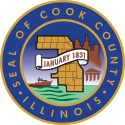Cook County Board Approves Planning for Progress Strategic Plan
Planning for Progress will guide Cook County’s use of an estimated $280 million in resources over the next five years.
The Cook County Board of Commissioners today approved Planning for Progress, the County’s comprehensive strategic plan designed to marshal existing funds, gather additional resources, and facilitate partnerships to meet housing, community, and economic development needs between 2015 and 2019. Cook County’s Bureau of Economic Development (BED) spearheaded Planning for Progress with technical assistance from the Chicago Metropolitan Agency for Planning (CMAP).
Planning for Progress combines two historically separate federally-required reports into a joint planning process and single, action-oriented document:
The Consolidated Plan, which is required by the U.S. Department of Housing and Urban Development (HUD) for local governments to receive Community Development Block Grant (CDBG), Emergency Solutions Grant (ESG), and HOME Investment Partnerships Program (HOME) funds; and
The Comprehensive Economic Development Strategy, which is required by the Economic Development Administration (EDA) to apply for Public Works or Economic Adjustment programs.
A single plan will help the County efficiently and effectively coordinate over $280 million in estimated resources between 2015 and 2019.
“As the largest county in the state, and the second largest in the nation, Cook County is a hub for residents and businesses,” Cook County Board President Toni Preckwinkle said. “Our strategic decision to create a single plan will help the County be more efficient and coordinated as we deploy nearly $300 million in estimated resources including federal funds over the next five years to address local issues and improve the quality of life for our residents.”
The process to create Planning for Progress began in October 2013. Over the past 15 months, the County and CMAP engaged more than 2,000 stakeholders, including public officials, business leaders, developers, service providers, major employers, other funders, and members of the general public in a dialogue about how to strategically plan for and implement federal resources.
As a result, Planning for Progress identifies five areas to strategically invest resources:
Infrastructure and Public Facilities
Business and Workforce Development Housing Development and Services Non-Housing Services Planning and Administration
This comprehensive approach is consistent with the GO TO 2040 regional plan and Cook County’s economic growth action plan, Partnering for Prosperity. CMAP supported Planning for Progress through the agency's Local Technical Assistance (LTA) program, which has helped more than 150 community-based planning projects since it began shortly after GO TO 2040 was adopted in October 2010.
Cook County’s Bureau of Economic Development will now submit the final Planning for Progress strategic plan to the U.S. Economic Development Administration (EDA) and the U.S. Department of Housing and Urban Development (HUD) in advance of their respective deadlines.
